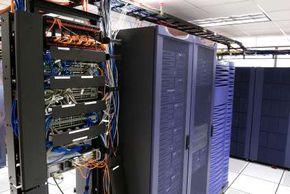Using North Carolina State University's computer lab once meant reserving a PC and then going to the lab at the available time -- possibly the middle of the night -- to work on it. That's no longer true, thanks to virtual computing. [source: North Carolina State University]
Today, students and faculty can reserve and log in to the NCSU Virtual Computing Laboratory anytime, anywhere from their own PCs or laptops. What's more, this remote-access system lets users choose the software they need, including industrial strength computer-assisted design (CAD) and engineering programs that take more memory than they have on their own systems. At the same time, professors can build customized software images in minutes for students to access anywhere.
Advertisement
Virtual computing makes one computer act and perform like many computers. Through virtual computing providers, users can download and use more than one operating system and perform a multitude of functions at the same time through a single mouse click and receive all the benefits of additional programs and hardware without having to purchase or install them on their own computer. Executives can check their company e-mail on the road, students can take classes from home and managers can keep up with documents stored on internal servers from anywhere in the world.
Virtual computing is increasing possibilities and performance in the world of information technology (IT): increased storage space, more software applications, performance and troubleshooting solutions, as well as data backup. In this article, we'll cover what virtual computing is, who performs the virtual services, the system requirements and the benefits and challenges to the user.
What is Virtual Computing?
Virtual computing allows computer users remote access to software applications and processes when they need it. Users gain access via the Internet through a wireless or network server. For a fee, users can boost their computers' capabilities, size, performance, processes and/or software applications whenever they need it. This real-time technology offers:
- Operating and utility systems
- Storage
- Memory
- Software
- Allocation and reassignment of input/output and other processes
- Data backup
- Automated problem solving and troubleshooting
- Tools for monitoring and managing systems
Users can access software applications for a single computer or an entire network because of the ability to select only what you need when you need it. They also can save or back up data and text documents to a virtual server (thus freeing space on individual computers) and reallocate or assign different processes to the virtual environment. This enables computers to operate at optimal speeds.
Virtual computing initially began as a method of borrowing space or storage for computer systems, but it's since grown significantly, offering data and software applications, as well as operating and utility systems. The corporate environment most commonly uses it, where IT system managers run multiple applications on several servers.
Advertisement



